Health and Safety Management HLTWHS001 Knowledge Questions Project
VerifiedAdded on 2023/06/14
|31
|3368
|211
Homework Assignment
AI Summary
This HLTWHS001 assessment solution provides detailed answers to knowledge questions related to health and safety management in an early childhood education and care setting. It covers relevant legislation, regulations, codes, and standards impacting WHS in the workplace, including the roles and responsibilities of employers and workers. The assessment also addresses hazard identification, risk assessment, and control measures, providing examples of common workplace hazards and hazardous manual handling tasks. Furthermore, it emphasizes the importance of infection control and outlines procedures for maintaining a safe environment for educators, children, and visitors. The solution includes hazard identification and risk assessment based on provided images of indoor and outdoor environments.
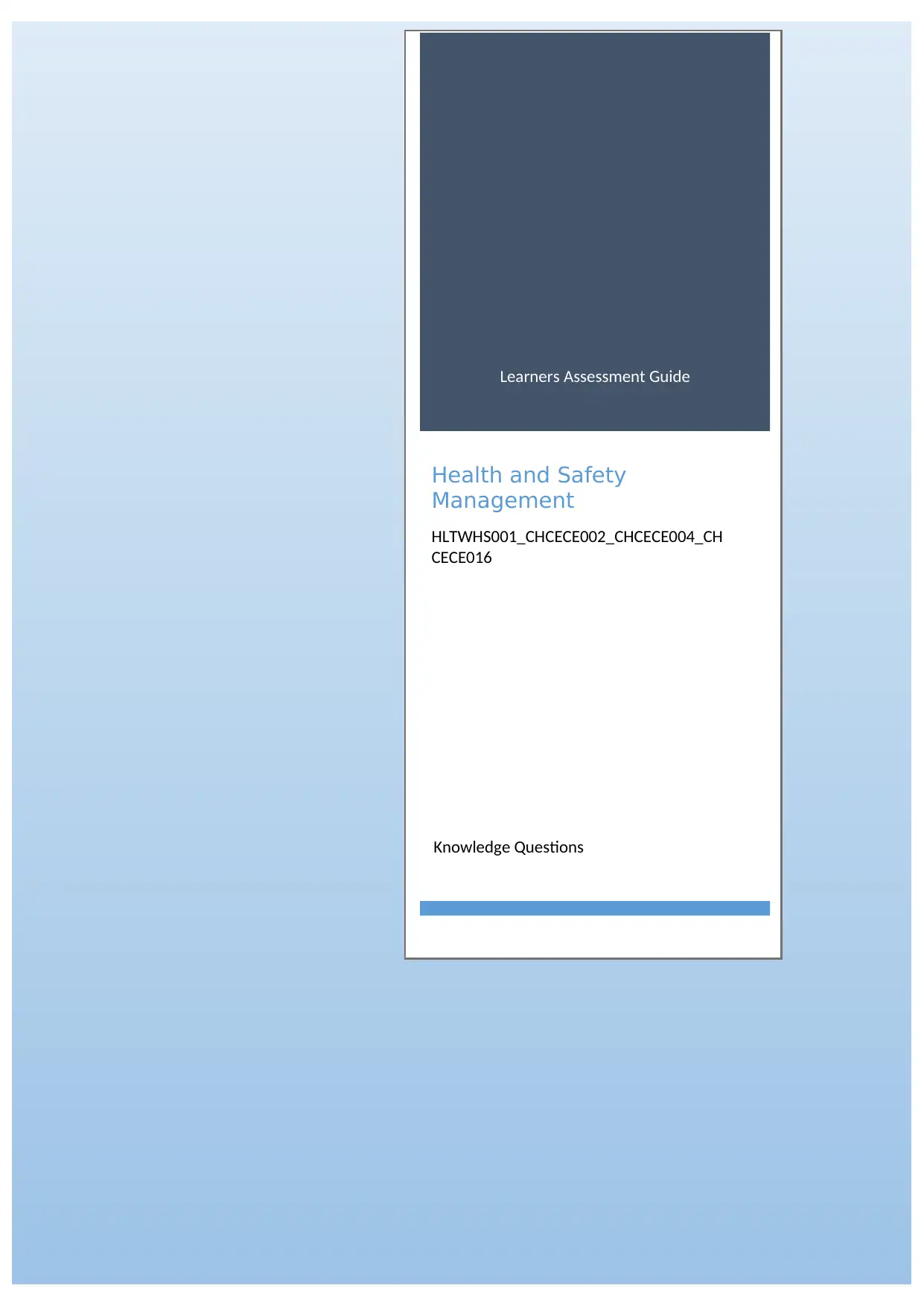
Learners Assessment Guide
Health and Safety
Management
HLTWHS001_CHCECE002_CHCECE004_CH
CECE016
Knowledge Questions
Health and Safety
Management
HLTWHS001_CHCECE002_CHCECE004_CH
CECE016
Knowledge Questions
Paraphrase This Document
Need a fresh take? Get an instant paraphrase of this document with our AI Paraphraser
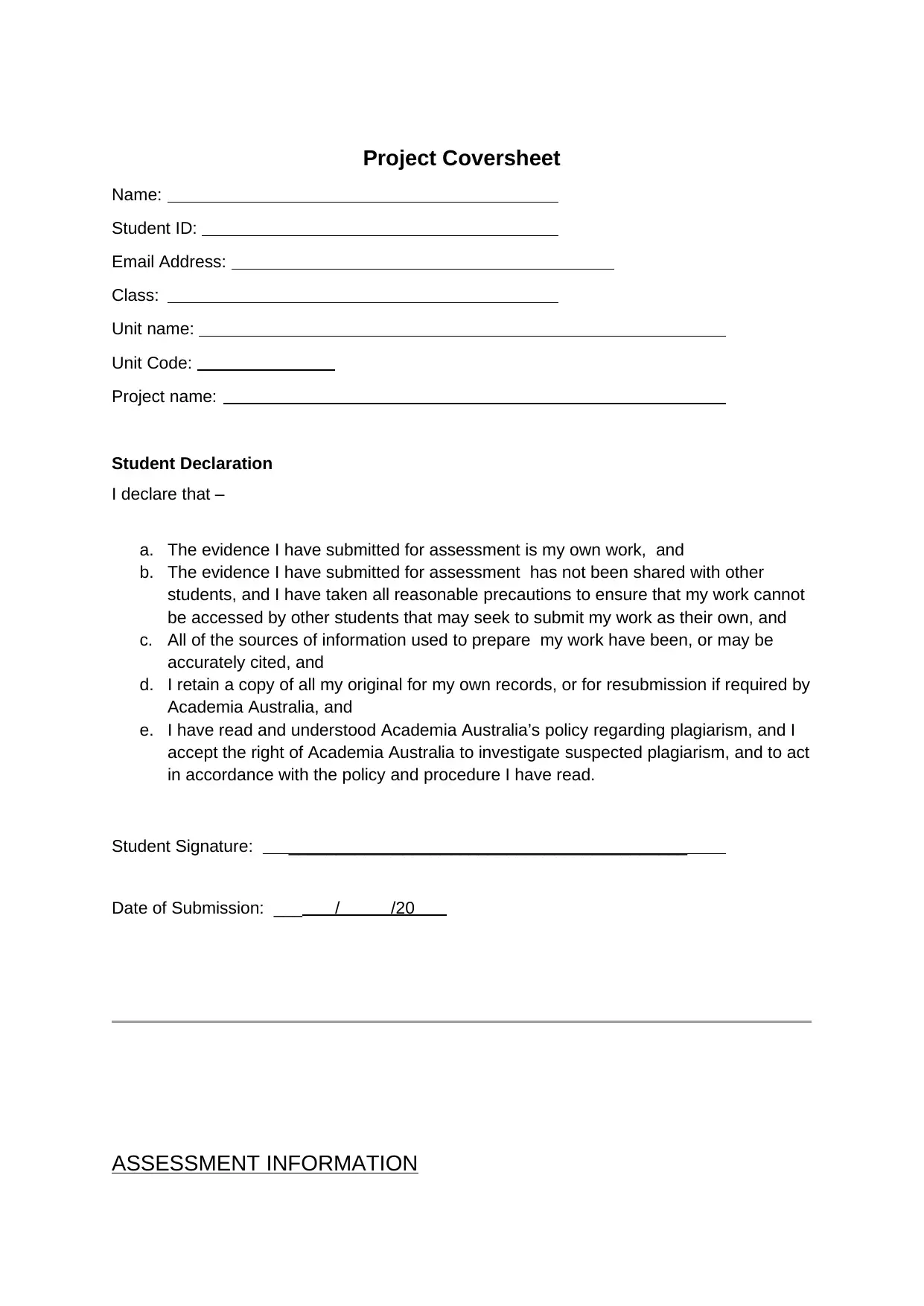
Project Coversheet
Name:
Student ID:
Email Address:
Class:
Unit name:
Unit Code:
Project name:
Student Declaration
I declare that –
a. The evidence I have submitted for assessment is my own work, and
b. The evidence I have submitted for assessment has not been shared with other
students, and I have taken all reasonable precautions to ensure that my work cannot
be accessed by other students that may seek to submit my work as their own, and
c. All of the sources of information used to prepare my work have been, or may be
accurately cited, and
d. I retain a copy of all my original for my own records, or for resubmission if required by
Academia Australia, and
e. I have read and understood Academia Australia’s policy regarding plagiarism, and I
accept the right of Academia Australia to investigate suspected plagiarism, and to act
in accordance with the policy and procedure I have read.
Student Signature: __________________________________________
Date of Submission: ___ / /20
ASSESSMENT INFORMATION
Name:
Student ID:
Email Address:
Class:
Unit name:
Unit Code:
Project name:
Student Declaration
I declare that –
a. The evidence I have submitted for assessment is my own work, and
b. The evidence I have submitted for assessment has not been shared with other
students, and I have taken all reasonable precautions to ensure that my work cannot
be accessed by other students that may seek to submit my work as their own, and
c. All of the sources of information used to prepare my work have been, or may be
accurately cited, and
d. I retain a copy of all my original for my own records, or for resubmission if required by
Academia Australia, and
e. I have read and understood Academia Australia’s policy regarding plagiarism, and I
accept the right of Academia Australia to investigate suspected plagiarism, and to act
in accordance with the policy and procedure I have read.
Student Signature: __________________________________________
Date of Submission: ___ / /20
ASSESSMENT INFORMATION
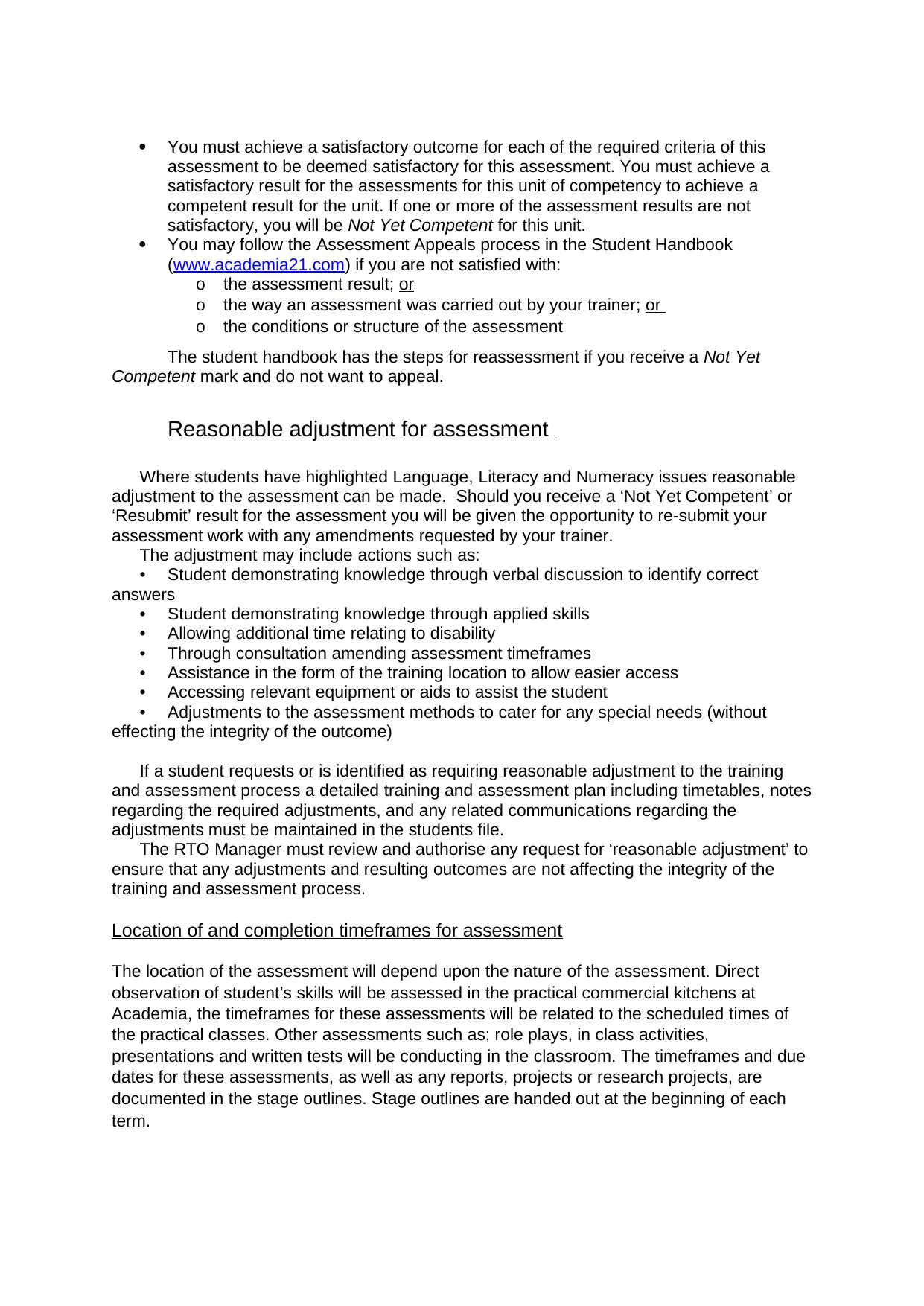
You must achieve a satisfactory outcome for each of the required criteria of this
assessment to be deemed satisfactory for this assessment. You must achieve a
satisfactory result for the assessments for this unit of competency to achieve a
competent result for the unit. If one or more of the assessment results are not
satisfactory, you will be Not Yet Competent for this unit.
You may follow the Assessment Appeals process in the Student Handbook
(www.academia21.com) if you are not satisfied with:
o the assessment result; or
o the way an assessment was carried out by your trainer; or
o the conditions or structure of the assessment
The student handbook has the steps for reassessment if you receive a Not Yet
Competent mark and do not want to appeal.
Reasonable adjustment for assessment
Where students have highlighted Language, Literacy and Numeracy issues reasonable
adjustment to the assessment can be made. Should you receive a ‘Not Yet Competent’ or
‘Resubmit’ result for the assessment you will be given the opportunity to re-submit your
assessment work with any amendments requested by your trainer.
The adjustment may include actions such as:
• Student demonstrating knowledge through verbal discussion to identify correct
answers
• Student demonstrating knowledge through applied skills
• Allowing additional time relating to disability
• Through consultation amending assessment timeframes
• Assistance in the form of the training location to allow easier access
• Accessing relevant equipment or aids to assist the student
• Adjustments to the assessment methods to cater for any special needs (without
effecting the integrity of the outcome)
If a student requests or is identified as requiring reasonable adjustment to the training
and assessment process a detailed training and assessment plan including timetables, notes
regarding the required adjustments, and any related communications regarding the
adjustments must be maintained in the students file.
The RTO Manager must review and authorise any request for ‘reasonable adjustment’ to
ensure that any adjustments and resulting outcomes are not affecting the integrity of the
training and assessment process.
Location of and completion timeframes for assessment
The location of the assessment will depend upon the nature of the assessment. Direct
observation of student’s skills will be assessed in the practical commercial kitchens at
Academia, the timeframes for these assessments will be related to the scheduled times of
the practical classes. Other assessments such as; role plays, in class activities,
presentations and written tests will be conducting in the classroom. The timeframes and due
dates for these assessments, as well as any reports, projects or research projects, are
documented in the stage outlines. Stage outlines are handed out at the beginning of each
term.
assessment to be deemed satisfactory for this assessment. You must achieve a
satisfactory result for the assessments for this unit of competency to achieve a
competent result for the unit. If one or more of the assessment results are not
satisfactory, you will be Not Yet Competent for this unit.
You may follow the Assessment Appeals process in the Student Handbook
(www.academia21.com) if you are not satisfied with:
o the assessment result; or
o the way an assessment was carried out by your trainer; or
o the conditions or structure of the assessment
The student handbook has the steps for reassessment if you receive a Not Yet
Competent mark and do not want to appeal.
Reasonable adjustment for assessment
Where students have highlighted Language, Literacy and Numeracy issues reasonable
adjustment to the assessment can be made. Should you receive a ‘Not Yet Competent’ or
‘Resubmit’ result for the assessment you will be given the opportunity to re-submit your
assessment work with any amendments requested by your trainer.
The adjustment may include actions such as:
• Student demonstrating knowledge through verbal discussion to identify correct
answers
• Student demonstrating knowledge through applied skills
• Allowing additional time relating to disability
• Through consultation amending assessment timeframes
• Assistance in the form of the training location to allow easier access
• Accessing relevant equipment or aids to assist the student
• Adjustments to the assessment methods to cater for any special needs (without
effecting the integrity of the outcome)
If a student requests or is identified as requiring reasonable adjustment to the training
and assessment process a detailed training and assessment plan including timetables, notes
regarding the required adjustments, and any related communications regarding the
adjustments must be maintained in the students file.
The RTO Manager must review and authorise any request for ‘reasonable adjustment’ to
ensure that any adjustments and resulting outcomes are not affecting the integrity of the
training and assessment process.
Location of and completion timeframes for assessment
The location of the assessment will depend upon the nature of the assessment. Direct
observation of student’s skills will be assessed in the practical commercial kitchens at
Academia, the timeframes for these assessments will be related to the scheduled times of
the practical classes. Other assessments such as; role plays, in class activities,
presentations and written tests will be conducting in the classroom. The timeframes and due
dates for these assessments, as well as any reports, projects or research projects, are
documented in the stage outlines. Stage outlines are handed out at the beginning of each
term.
⊘ This is a preview!⊘
Do you want full access?
Subscribe today to unlock all pages.

Trusted by 1+ million students worldwide
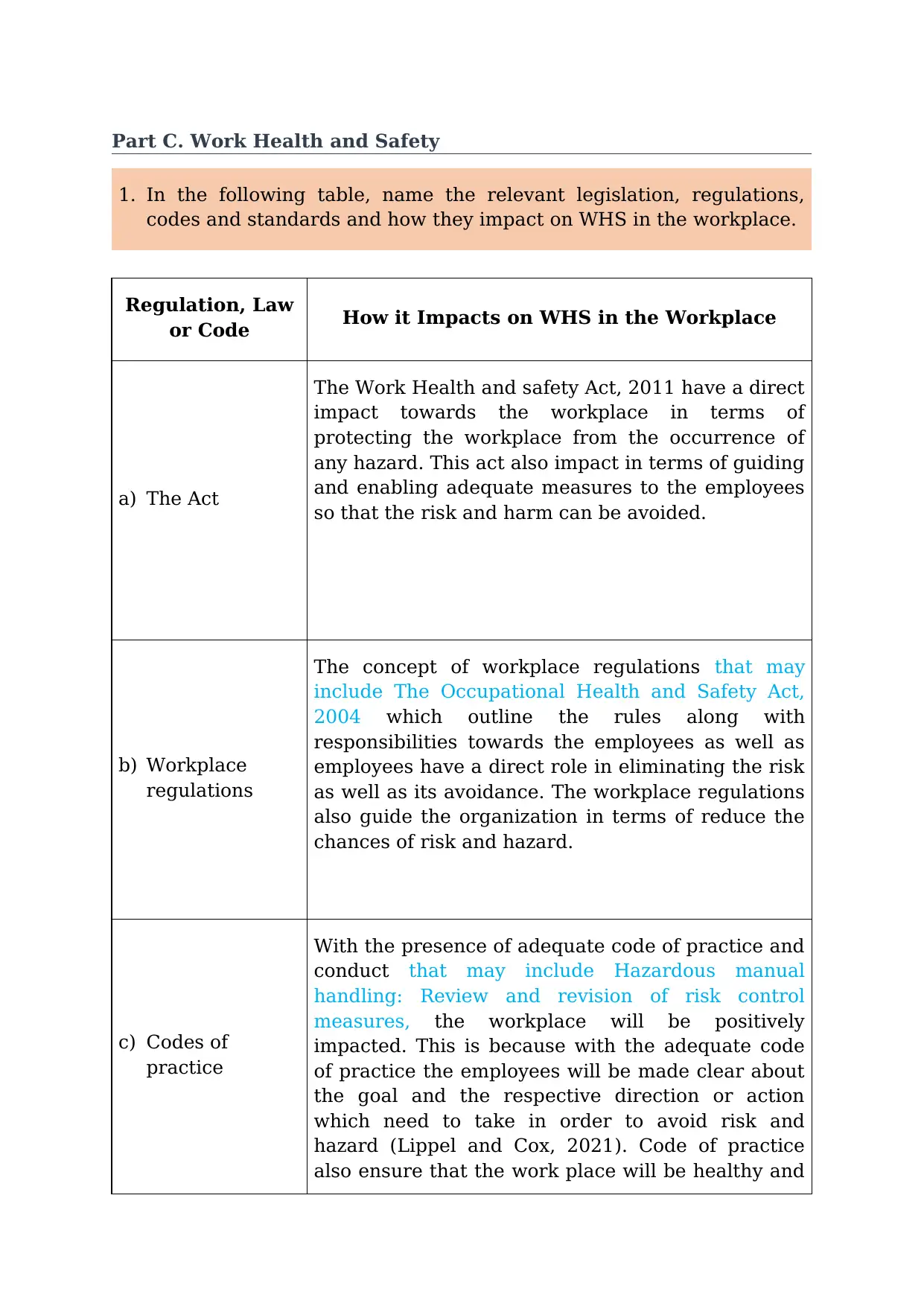
Part C. Work Health and Safety
1. In the following table, name the relevant legislation, regulations,
codes and standards and how they impact on WHS in the workplace.
Regulation, Law
or Code How it Impacts on WHS in the Workplace
a) The Act
The Work Health and safety Act, 2011 have a direct
impact towards the workplace in terms of
protecting the workplace from the occurrence of
any hazard. This act also impact in terms of guiding
and enabling adequate measures to the employees
so that the risk and harm can be avoided.
b) Workplace
regulations
The concept of workplace regulations that may
include The Occupational Health and Safety Act,
2004 which outline the rules along with
responsibilities towards the employees as well as
employees have a direct role in eliminating the risk
as well as its avoidance. The workplace regulations
also guide the organization in terms of reduce the
chances of risk and hazard.
c) Codes of
practice
With the presence of adequate code of practice and
conduct that may include Hazardous manual
handling: Review and revision of risk control
measures, the workplace will be positively
impacted. This is because with the adequate code
of practice the employees will be made clear about
the goal and the respective direction or action
which need to take in order to avoid risk and
hazard (Lippel and Cox, 2021). Code of practice
also ensure that the work place will be healthy and
1. In the following table, name the relevant legislation, regulations,
codes and standards and how they impact on WHS in the workplace.
Regulation, Law
or Code How it Impacts on WHS in the Workplace
a) The Act
The Work Health and safety Act, 2011 have a direct
impact towards the workplace in terms of
protecting the workplace from the occurrence of
any hazard. This act also impact in terms of guiding
and enabling adequate measures to the employees
so that the risk and harm can be avoided.
b) Workplace
regulations
The concept of workplace regulations that may
include The Occupational Health and Safety Act,
2004 which outline the rules along with
responsibilities towards the employees as well as
employees have a direct role in eliminating the risk
as well as its avoidance. The workplace regulations
also guide the organization in terms of reduce the
chances of risk and hazard.
c) Codes of
practice
With the presence of adequate code of practice and
conduct that may include Hazardous manual
handling: Review and revision of risk control
measures, the workplace will be positively
impacted. This is because with the adequate code
of practice the employees will be made clear about
the goal and the respective direction or action
which need to take in order to avoid risk and
hazard (Lippel and Cox, 2021). Code of practice
also ensure that the work place will be healthy and
Paraphrase This Document
Need a fresh take? Get an instant paraphrase of this document with our AI Paraphraser
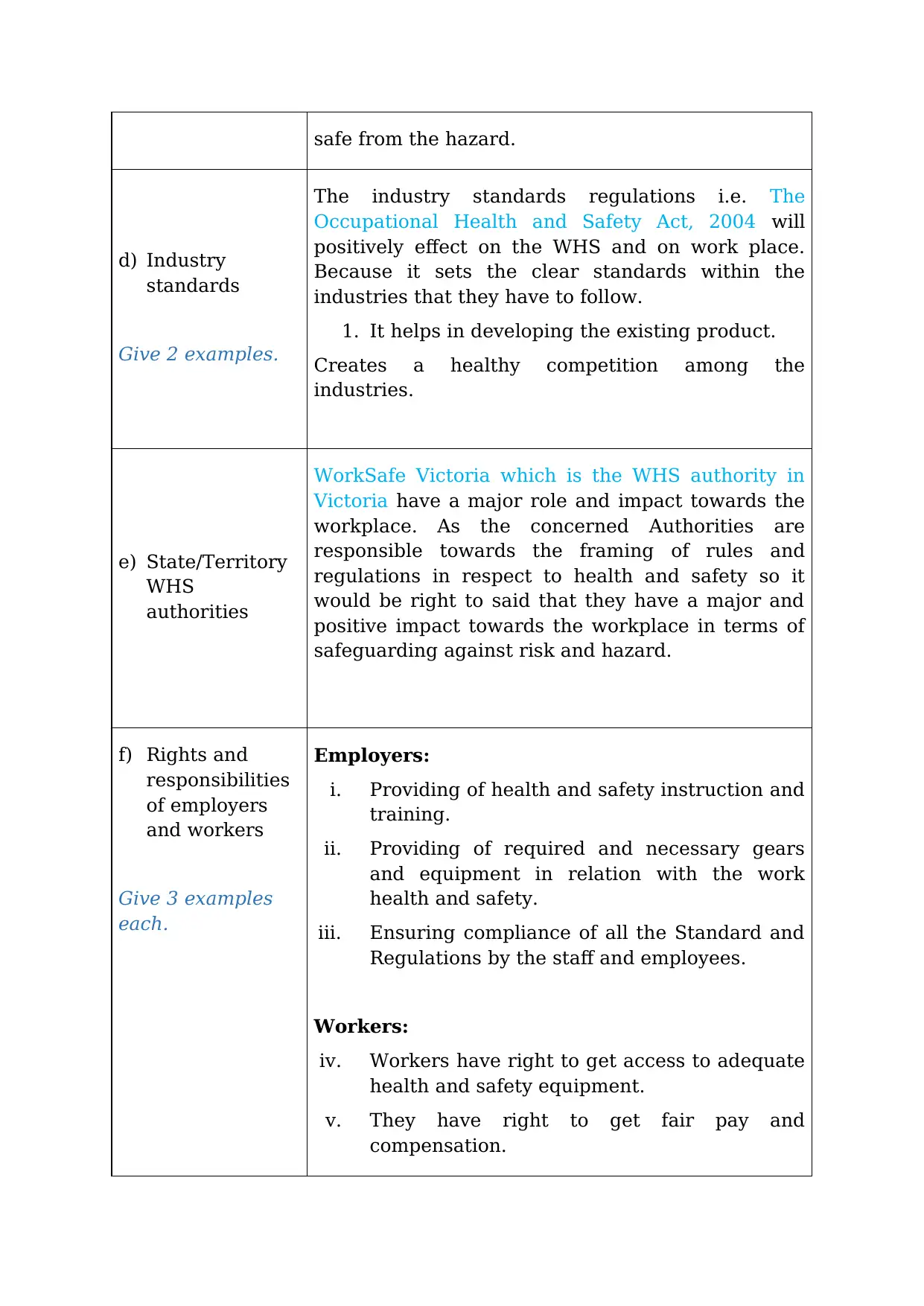
safe from the hazard.
d) Industry
standards
Give 2 examples.
The industry standards regulations i.e. The
Occupational Health and Safety Act, 2004 will
positively effect on the WHS and on work place.
Because it sets the clear standards within the
industries that they have to follow.
1. It helps in developing the existing product.
Creates a healthy competition among the
industries.
e) State/Territory
WHS
authorities
WorkSafe Victoria which is the WHS authority in
Victoria have a major role and impact towards the
workplace. As the concerned Authorities are
responsible towards the framing of rules and
regulations in respect to health and safety so it
would be right to said that they have a major and
positive impact towards the workplace in terms of
safeguarding against risk and hazard.
f) Rights and
responsibilities
of employers
and workers
Give 3 examples
each.
Employers:
i. Providing of health and safety instruction and
training.
ii. Providing of required and necessary gears
and equipment in relation with the work
health and safety.
iii. Ensuring compliance of all the Standard and
Regulations by the staff and employees.
Workers:
iv. Workers have right to get access to adequate
health and safety equipment.
v. They have right to get fair pay and
compensation.
d) Industry
standards
Give 2 examples.
The industry standards regulations i.e. The
Occupational Health and Safety Act, 2004 will
positively effect on the WHS and on work place.
Because it sets the clear standards within the
industries that they have to follow.
1. It helps in developing the existing product.
Creates a healthy competition among the
industries.
e) State/Territory
WHS
authorities
WorkSafe Victoria which is the WHS authority in
Victoria have a major role and impact towards the
workplace. As the concerned Authorities are
responsible towards the framing of rules and
regulations in respect to health and safety so it
would be right to said that they have a major and
positive impact towards the workplace in terms of
safeguarding against risk and hazard.
f) Rights and
responsibilities
of employers
and workers
Give 3 examples
each.
Employers:
i. Providing of health and safety instruction and
training.
ii. Providing of required and necessary gears
and equipment in relation with the work
health and safety.
iii. Ensuring compliance of all the Standard and
Regulations by the staff and employees.
Workers:
iv. Workers have right to get access to adequate
health and safety equipment.
v. They have right to get fair pay and
compensation.
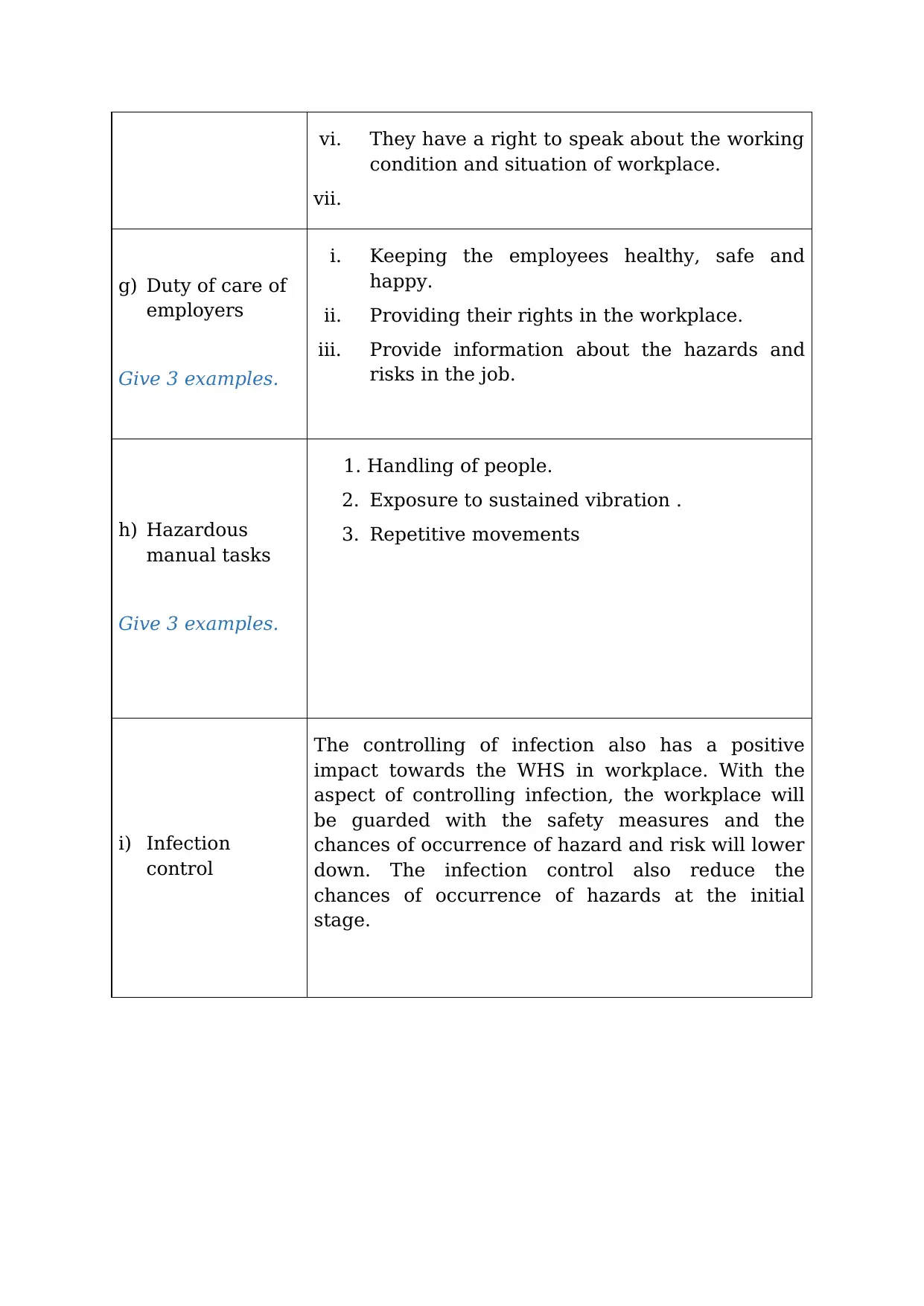
vi. They have a right to speak about the working
condition and situation of workplace.
vii.
g) Duty of care of
employers
Give 3 examples.
i. Keeping the employees healthy, safe and
happy.
ii. Providing their rights in the workplace.
iii. Provide information about the hazards and
risks in the job.
h) Hazardous
manual tasks
Give 3 examples.
1. Handling of people.
2. Exposure to sustained vibration .
3. Repetitive movements
i) Infection
control
The controlling of infection also has a positive
impact towards the WHS in workplace. With the
aspect of controlling infection, the workplace will
be guarded with the safety measures and the
chances of occurrence of hazard and risk will lower
down. The infection control also reduce the
chances of occurrence of hazards at the initial
stage.
condition and situation of workplace.
vii.
g) Duty of care of
employers
Give 3 examples.
i. Keeping the employees healthy, safe and
happy.
ii. Providing their rights in the workplace.
iii. Provide information about the hazards and
risks in the job.
h) Hazardous
manual tasks
Give 3 examples.
1. Handling of people.
2. Exposure to sustained vibration .
3. Repetitive movements
i) Infection
control
The controlling of infection also has a positive
impact towards the WHS in workplace. With the
aspect of controlling infection, the workplace will
be guarded with the safety measures and the
chances of occurrence of hazard and risk will lower
down. The infection control also reduce the
chances of occurrence of hazards at the initial
stage.
⊘ This is a preview!⊘
Do you want full access?
Subscribe today to unlock all pages.

Trusted by 1+ million students worldwide
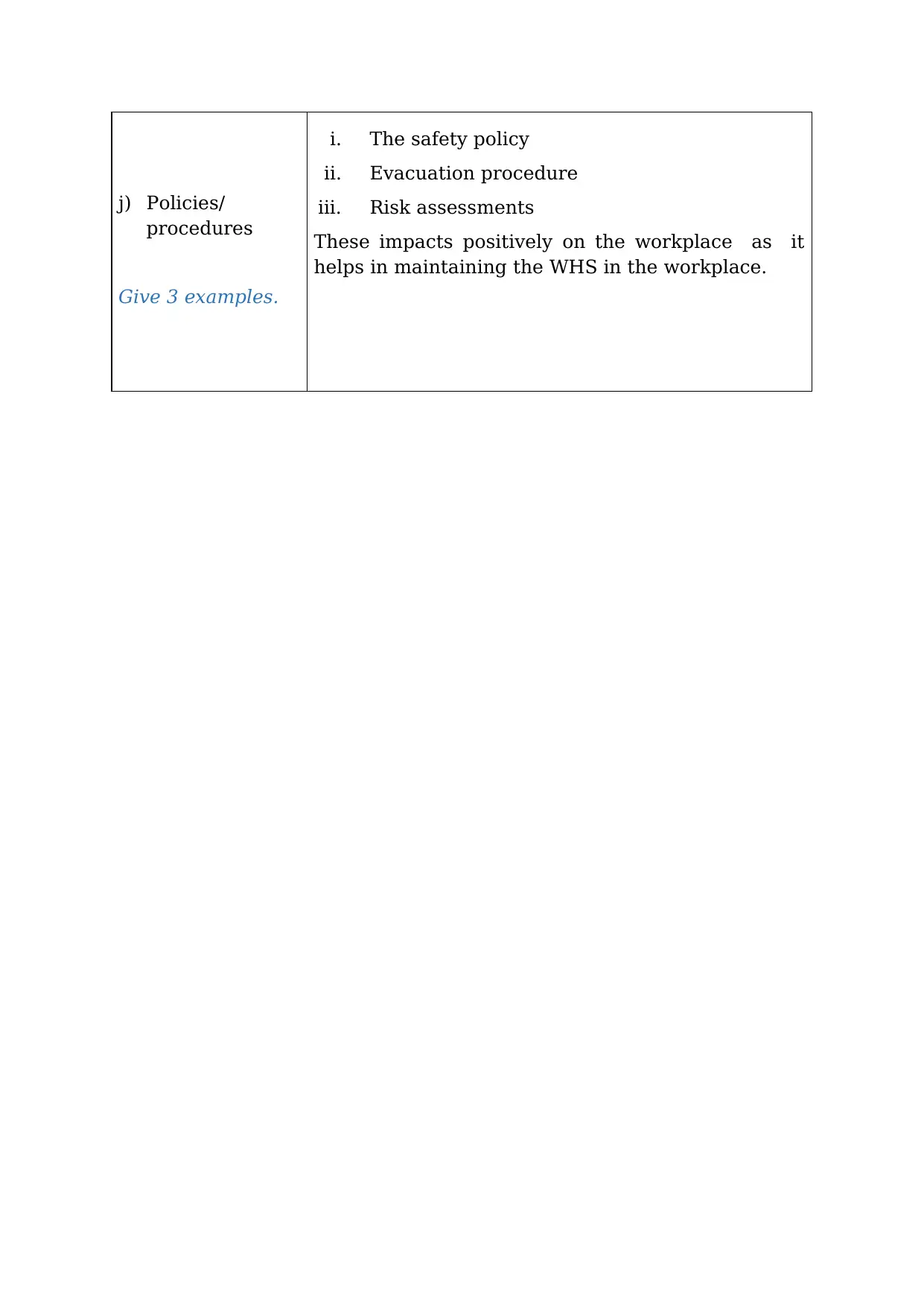
j) Policies/
procedures
Give 3 examples.
i. The safety policy
ii. Evacuation procedure
iii. Risk assessments
These impacts positively on the workplace as it
helps in maintaining the WHS in the workplace.
procedures
Give 3 examples.
i. The safety policy
ii. Evacuation procedure
iii. Risk assessments
These impacts positively on the workplace as it
helps in maintaining the WHS in the workplace.
Paraphrase This Document
Need a fresh take? Get an instant paraphrase of this document with our AI Paraphraser
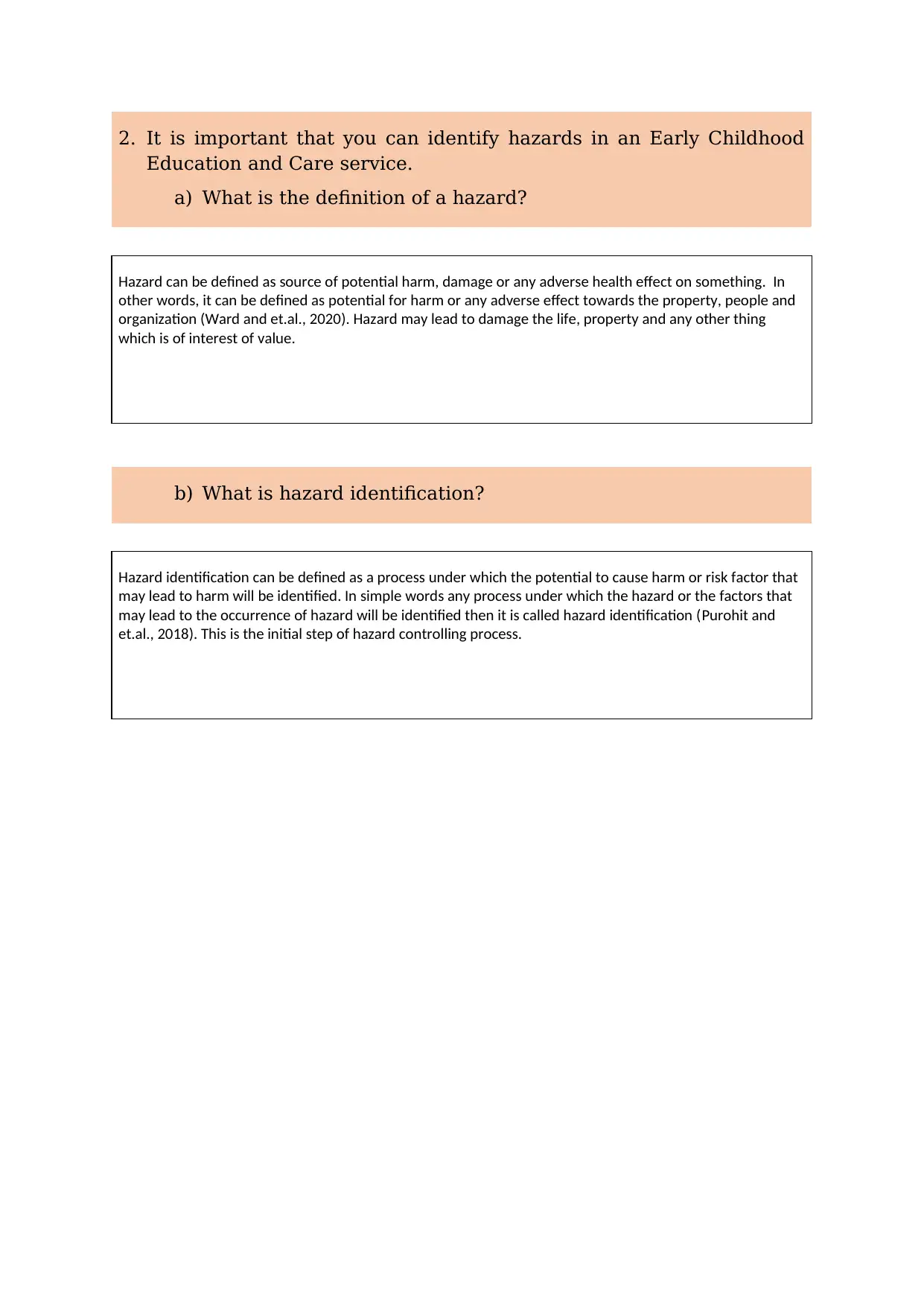
2. It is important that you can identify hazards in an Early Childhood
Education and Care service.
a) What is the definition of a hazard?
Hazard can be defined as source of potential harm, damage or any adverse health effect on something. In
other words, it can be defined as potential for harm or any adverse effect towards the property, people and
organization (Ward and et.al., 2020). Hazard may lead to damage the life, property and any other thing
which is of interest of value.
b) What is hazard identification?
Hazard identification can be defined as a process under which the potential to cause harm or risk factor that
may lead to harm will be identified. In simple words any process under which the hazard or the factors that
may lead to the occurrence of hazard will be identified then it is called hazard identification (Purohit and
et.al., 2018). This is the initial step of hazard controlling process.
Education and Care service.
a) What is the definition of a hazard?
Hazard can be defined as source of potential harm, damage or any adverse health effect on something. In
other words, it can be defined as potential for harm or any adverse effect towards the property, people and
organization (Ward and et.al., 2020). Hazard may lead to damage the life, property and any other thing
which is of interest of value.
b) What is hazard identification?
Hazard identification can be defined as a process under which the potential to cause harm or risk factor that
may lead to harm will be identified. In simple words any process under which the hazard or the factors that
may lead to the occurrence of hazard will be identified then it is called hazard identification (Purohit and
et.al., 2018). This is the initial step of hazard controlling process.
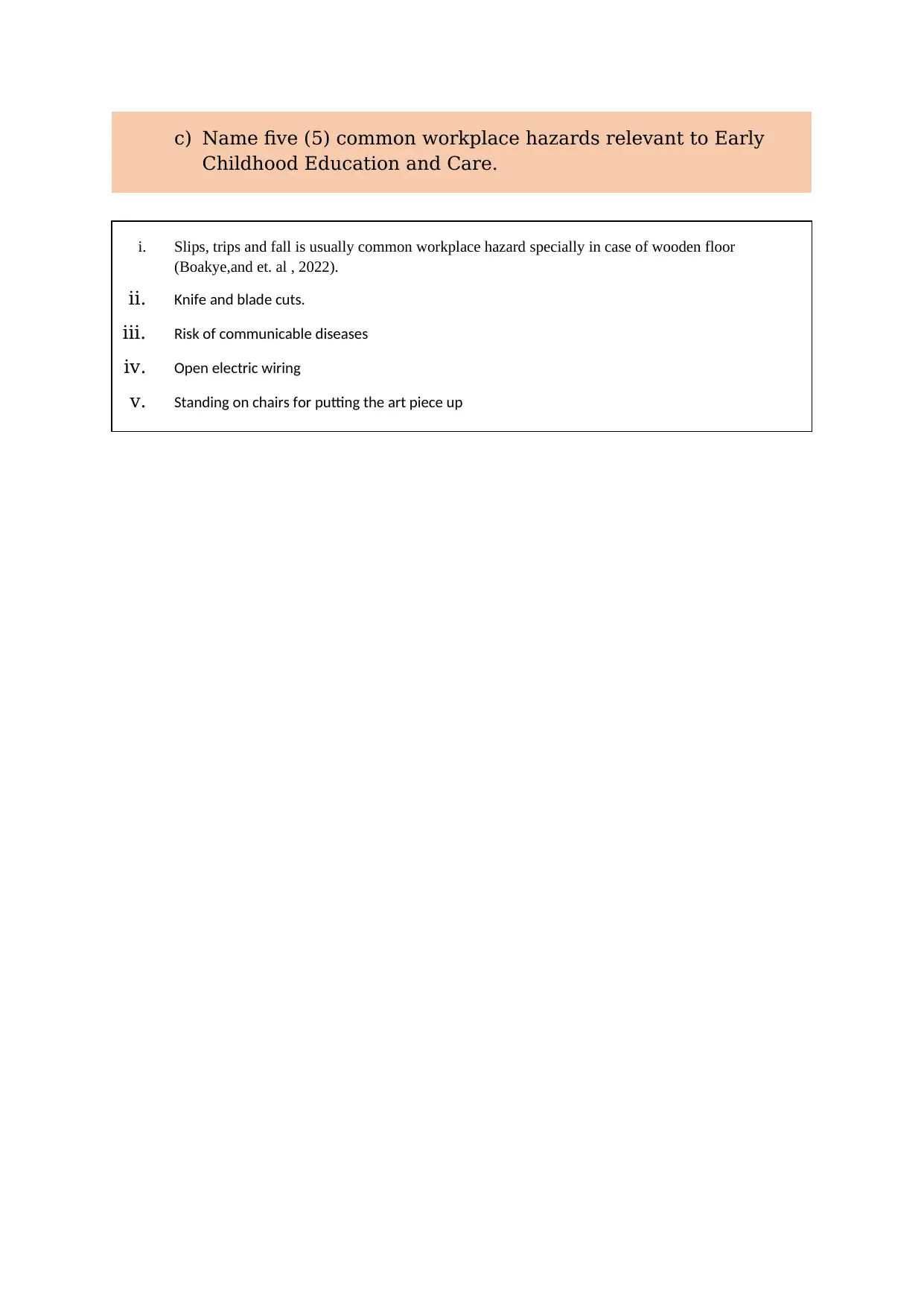
c) Name five (5) common workplace hazards relevant to Early
Childhood Education and Care.
i. Slips, trips and fall is usually common workplace hazard specially in case of wooden floor
(Boakye,and et. al , 2022).
ii. Knife and blade cuts.
iii. Risk of communicable diseases
iv. Open electric wiring
v. Standing on chairs for putting the art piece up
Childhood Education and Care.
i. Slips, trips and fall is usually common workplace hazard specially in case of wooden floor
(Boakye,and et. al , 2022).
ii. Knife and blade cuts.
iii. Risk of communicable diseases
iv. Open electric wiring
v. Standing on chairs for putting the art piece up
⊘ This is a preview!⊘
Do you want full access?
Subscribe today to unlock all pages.

Trusted by 1+ million students worldwide
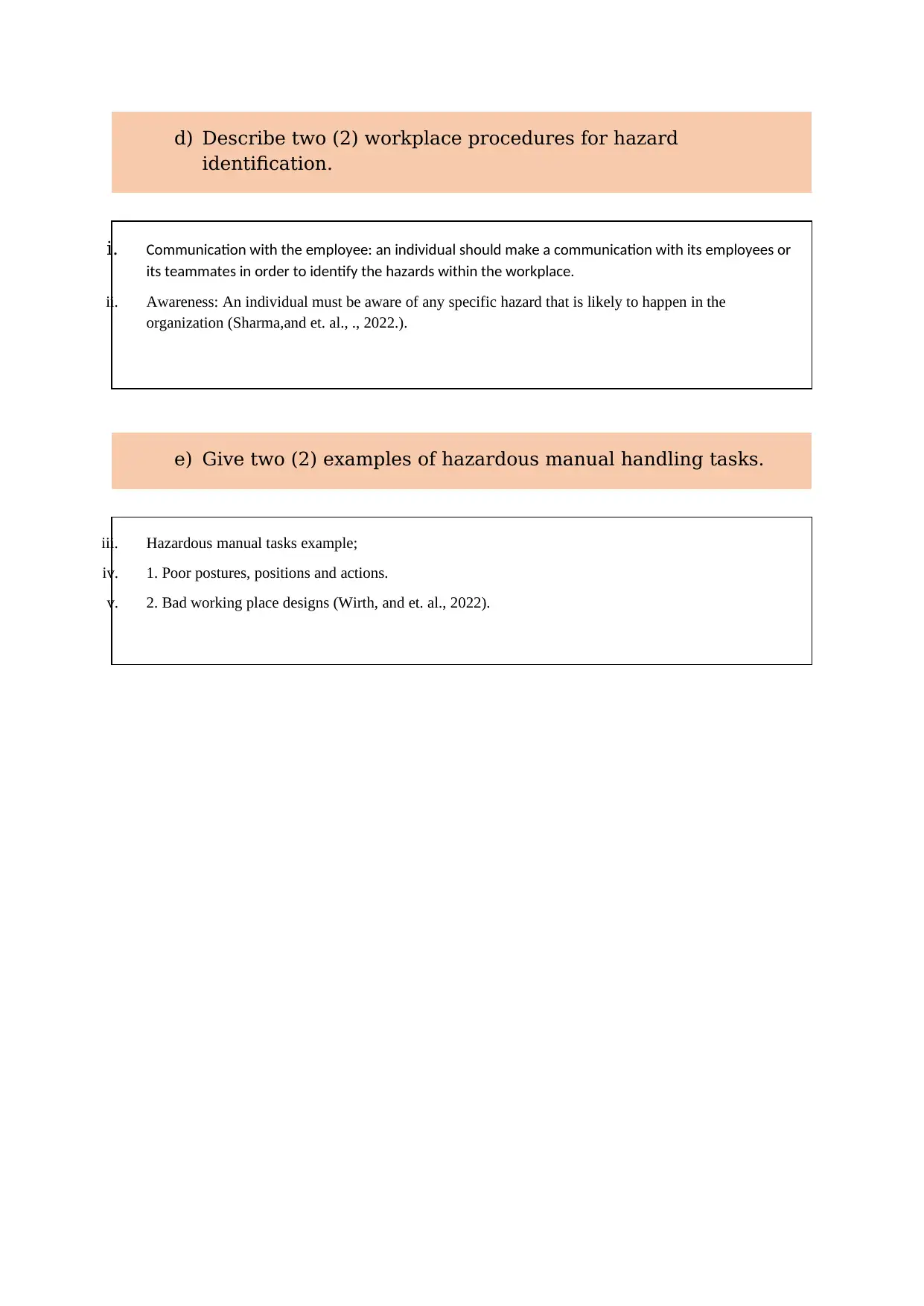
d) Describe two (2) workplace procedures for hazard
identification.
i. Communication with the employee: an individual should make a communication with its employees or
its teammates in order to identify the hazards within the workplace.
ii. Awareness: An individual must be aware of any specific hazard that is likely to happen in the
organization (Sharma,and et. al., ., 2022.).
e) Give two (2) examples of hazardous manual handling tasks.
iii. Hazardous manual tasks example;
iv. 1. Poor postures, positions and actions.
v. 2. Bad working place designs (Wirth, and et. al., 2022).
identification.
i. Communication with the employee: an individual should make a communication with its employees or
its teammates in order to identify the hazards within the workplace.
ii. Awareness: An individual must be aware of any specific hazard that is likely to happen in the
organization (Sharma,and et. al., ., 2022.).
e) Give two (2) examples of hazardous manual handling tasks.
iii. Hazardous manual tasks example;
iv. 1. Poor postures, positions and actions.
v. 2. Bad working place designs (Wirth, and et. al., 2022).
Paraphrase This Document
Need a fresh take? Get an instant paraphrase of this document with our AI Paraphraser
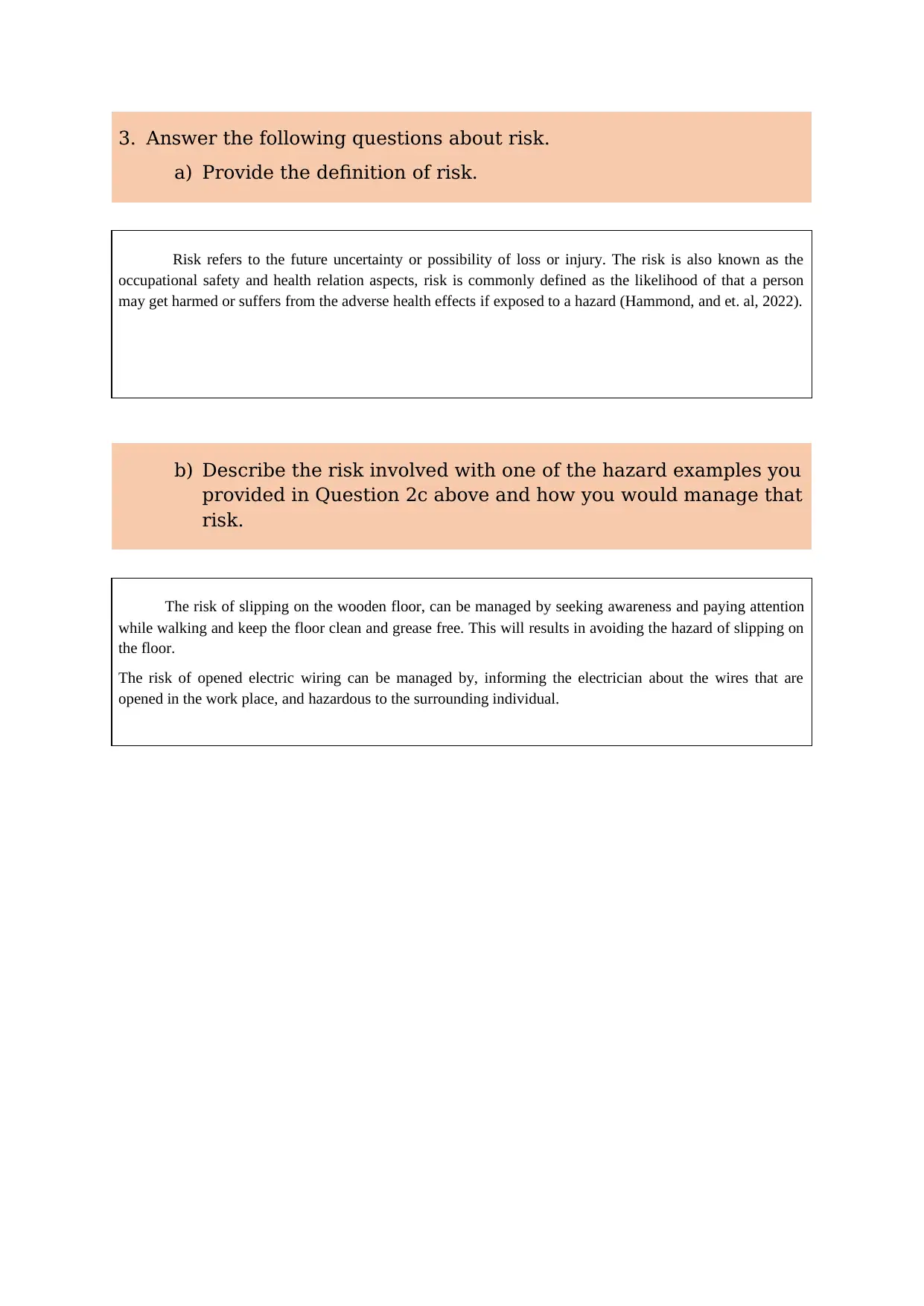
3. Answer the following questions about risk.
a) Provide the definition of risk.
Risk refers to the future uncertainty or possibility of loss or injury. The risk is also known as the
occupational safety and health relation aspects, risk is commonly defined as the likelihood of that a person
may get harmed or suffers from the adverse health effects if exposed to a hazard (Hammond, and et. al, 2022).
b) Describe the risk involved with one of the hazard examples you
provided in Question 2c above and how you would manage that
risk.
The risk of slipping on the wooden floor, can be managed by seeking awareness and paying attention
while walking and keep the floor clean and grease free. This will results in avoiding the hazard of slipping on
the floor.
The risk of opened electric wiring can be managed by, informing the electrician about the wires that are
opened in the work place, and hazardous to the surrounding individual.
a) Provide the definition of risk.
Risk refers to the future uncertainty or possibility of loss or injury. The risk is also known as the
occupational safety and health relation aspects, risk is commonly defined as the likelihood of that a person
may get harmed or suffers from the adverse health effects if exposed to a hazard (Hammond, and et. al, 2022).
b) Describe the risk involved with one of the hazard examples you
provided in Question 2c above and how you would manage that
risk.
The risk of slipping on the wooden floor, can be managed by seeking awareness and paying attention
while walking and keep the floor clean and grease free. This will results in avoiding the hazard of slipping on
the floor.
The risk of opened electric wiring can be managed by, informing the electrician about the wires that are
opened in the work place, and hazardous to the surrounding individual.
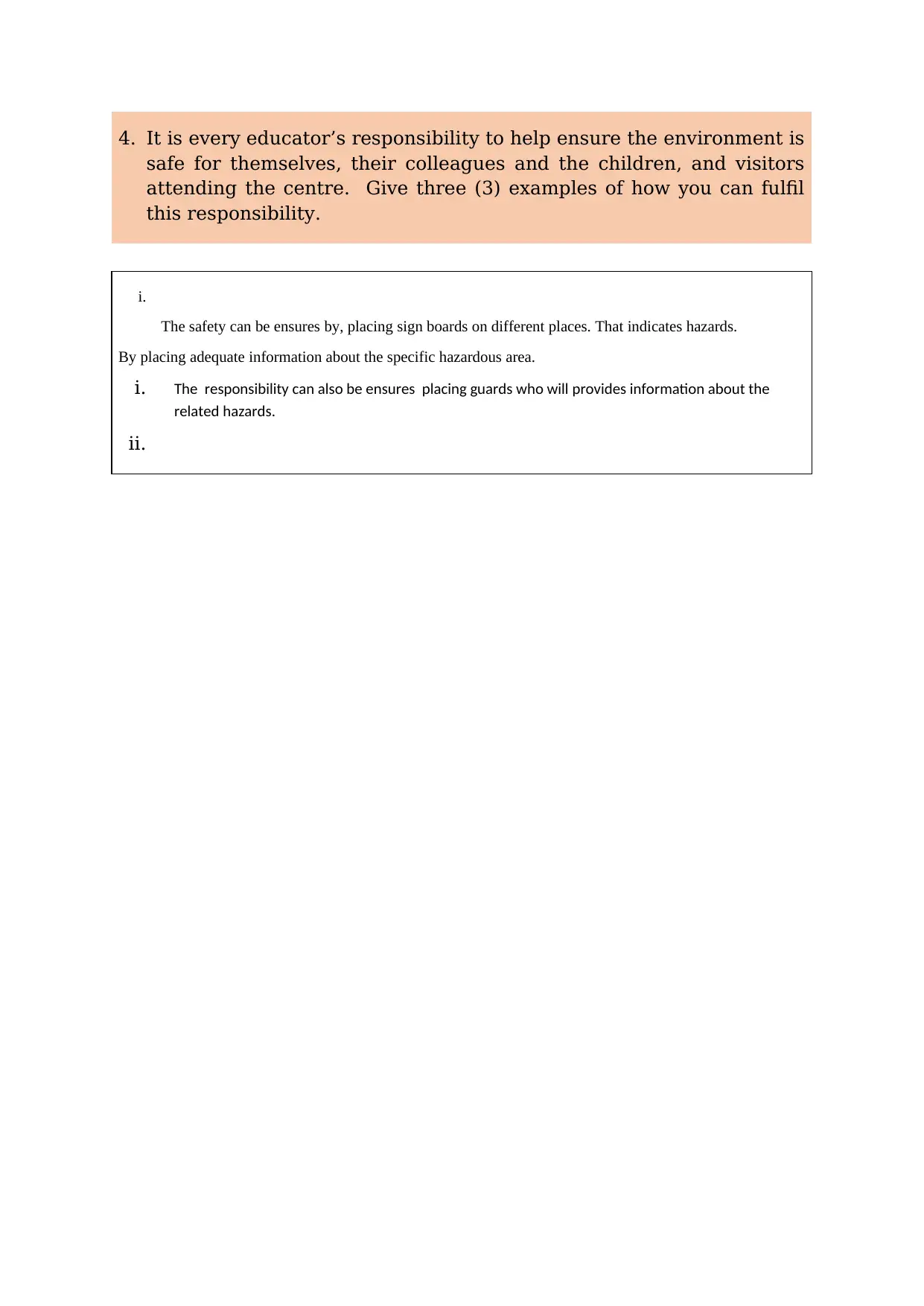
4. It is every educator’s responsibility to help ensure the environment is
safe for themselves, their colleagues and the children, and visitors
attending the centre. Give three (3) examples of how you can fulfil
this responsibility.
i.
The safety can be ensures by, placing sign boards on different places. That indicates hazards.
By placing adequate information about the specific hazardous area.
i. The responsibility can also be ensures placing guards who will provides information about the
related hazards.
ii.
safe for themselves, their colleagues and the children, and visitors
attending the centre. Give three (3) examples of how you can fulfil
this responsibility.
i.
The safety can be ensures by, placing sign boards on different places. That indicates hazards.
By placing adequate information about the specific hazardous area.
i. The responsibility can also be ensures placing guards who will provides information about the
related hazards.
ii.
⊘ This is a preview!⊘
Do you want full access?
Subscribe today to unlock all pages.

Trusted by 1+ million students worldwide
1 out of 31
Related Documents
Your All-in-One AI-Powered Toolkit for Academic Success.
+13062052269
info@desklib.com
Available 24*7 on WhatsApp / Email
![[object Object]](/_next/static/media/star-bottom.7253800d.svg)
Unlock your academic potential
Copyright © 2020–2025 A2Z Services. All Rights Reserved. Developed and managed by ZUCOL.




